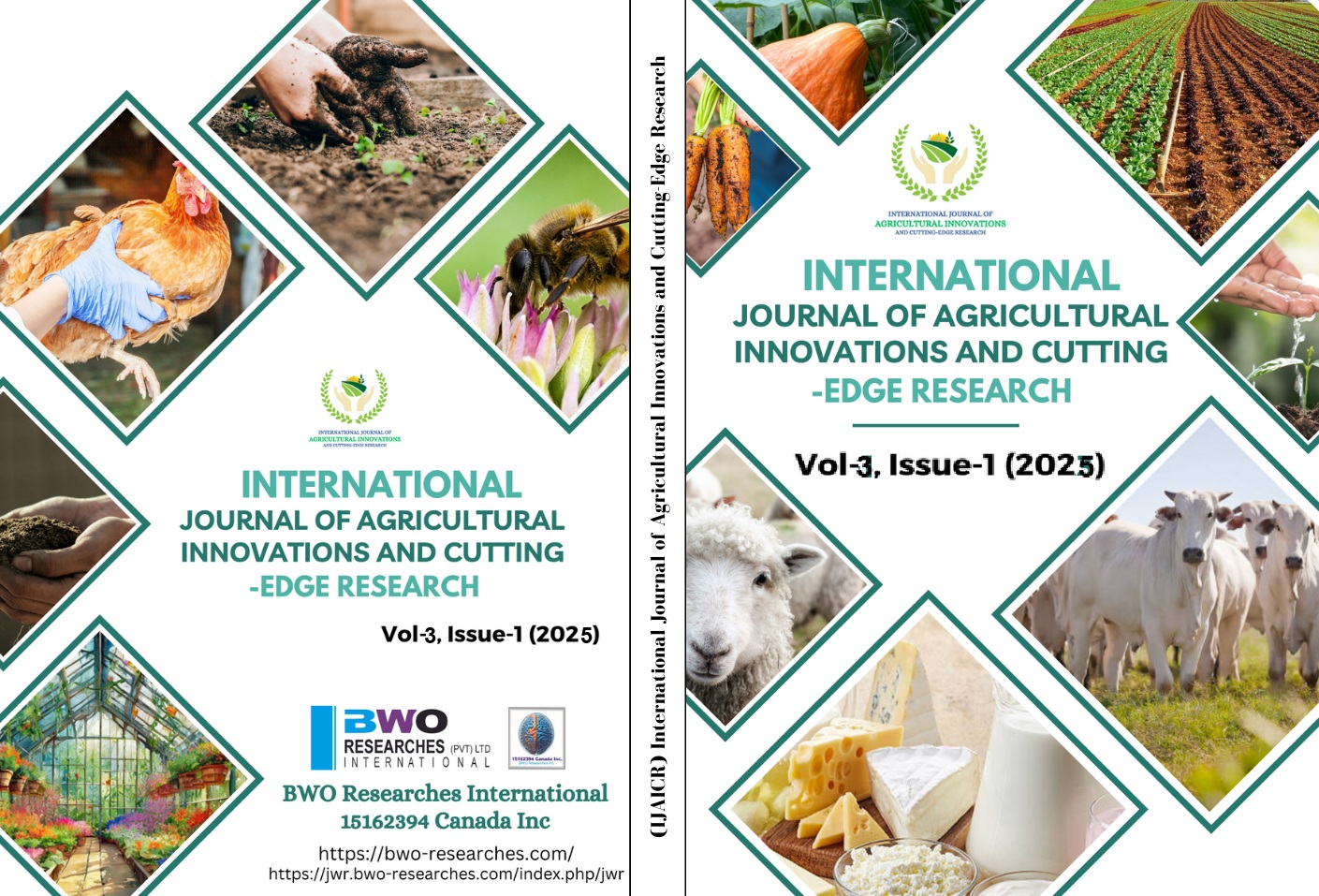Impacts of Solar-Powered Irrigation on Groundwater and Crop Yield: A Case Study of Kurram District, Pakistan
Keywords:
Solar, Power , Irrigation , Tubewell , Variation , SPISAbstract
Farmers are rapidly transitioning from traditional to solar-powered irrigation systems (SPIS). A comprehensive study is needed to evaluate the advantages and disadvantages of SPIS. This study builds on previous research and incorporates field data collected in 2019 and 2024. In the Kurram district, crops are irrigated using both surface and groundwater resources. For this research, 54 tubewells solarized by the Directorate General of Agricultural Engineering, Khyber Pakhtunkhwa, were selected. Data on water table levels, discharge rates, and variations in crop yield were collected before (2019) and after (2024) the installation of SPIS. Water table declination was observed at six locations, while a rise in the water table was noted at two locations. The discharge rate of all tubewells remained consistent at approximately 5,000 gallons per hour (mph). Following the installation of SPIS, both the cropping area and yield per unit area increased significantly. The study found that farmers can recover their investment in SPIS, including costs for pumps, PV panels, inverters, and manually rotating structures, within 1.1 to 1.4 years. The government and policymakers should consider implementing policies and incentives to promote the widespread adoption of solar energy in agriculture. It is recommended that solar energy be utilized to power high-efficiency irrigation systems (HEIS), with an urgent focus on capacity building among farmers, advisors, and system installers to ensure sustainable water resource management. Furthermore, the adoption of SPIS can enhance crop yields, contributing to food security and poverty reduction.
References
Ali, S., Liu, Y., Ishaq, M., Shah, T., Ilyas, A., & Din, I. U. (2019). Climate change and its impact on the yield of major food crops: Evidence from Pakistan. Foods, 8(9), 398.
Bakhsh, A., Chaudhary, J. N., Ali, A., Rizwan, M., & Hussain, M. (2016). Tube wells run on solar energy and it's used in agriculture. Journal of Renewable Energy and Agriculture, 15(3), 45-60.
Bashir, M. K., Schilizzi, S., & Pandit, R. (2020). The determinants of rural household food security in the Punjab, Pakistan: An econometric analysis. Journal of Agricultural Economics, 71(1), 213-234.
Besser, H., Dhaouadi, L., Hadji, R., Hamed, Y., & Jemmali, H. (2021). Ecologic and economic perspectives for sustainable irrigated agriculture under arid climate conditions: An analysis based on environmental indicators for southern Tunisia. Journal of African Earth Sciences, 177, 104134.
Bukhari, M. D., Khan, H. F., Hameed, M. S., Yasir, M., Safdar, M., Ahmad, U., & Khawaja, W. A. (2023). Feasibility and Comparative Analysis of Solar Power Tube Well with Existing Conventional Systems and its Utilization in Irrigation of the Agricultural Lands. PalArch's Journal of Archaeology of Egypt/Egyptology, 20(2), 1070-1081.
Burney, J., Woltering, L., Burke, M., Naylor, R., & Pasternak, D. (2010). Solar-powered drip irrigation enhances food security in the Sudano–Sahel. Proceedings of the National Academy of Sciences, 107(5), 1848-1853.
Closas, A., & Rap, E. (2017). Solar-based groundwater pumping for irrigation: Sustainability, policies, and limitations. Energy Policy, 104, 33-37.
FAO. 2011. Save and Grow: A policy-maker’s guide to the sustainable intensification of smallholder crop production. FAO, Rome. www.fao.org/docrep/014/ i2215e/i2215e
FAO Land and Water Division. Accessed April 12, 2019. http://www.fao.org/nr/water/aquastat/data /query /results .html.
Friends of Democratic Pakistan. 2012. A Productive and Water-Secure Pakistan: Infrastructure, Institutions, Strategy. A Report of the Water Sector Task Force of the Friends of Democratic Pakistan, Islamabad. Report-Final-09-29-12.
Guta, D. D., Börner, J., & Diriba, D. (2017). Energy and food security implications of solar-powered groundwater irrigation in Ethiopia. Energy Policy, 101, 21-29.
H. Hartung and L. Pluschke, "The benefits and risks of solar-powered irrigation - a global overview," Food and Agriculture Organization of the United Nations; Deutsche Gesellschaft für International Zusammenarbeit, 2018.
Hussain, F., Maeng, S.-J., Cheema, M. J. M., Anjum, M. N., Afzal, A., Azam, M., Wu, R.-S., Noor, R. S., Umair, M., & Iqbal, T. (2023). Solar Irrigation Potential, Key Issues and Challenges in Pakistan. Water, 15(9), 1727.
Iqbal, N., Ashraf, M., Imran, M., Salam, H., Hasan, F., & Khan, A. (2020). Groundwater Investigations and Mapping in the Lower Indus Plain. Islamabad: Pakistan Council of Research in Water Resources (PCRWR).
Khalil, A., Smith, J., & Brown, L. (2008). Solar-powered irrigation systems: A review of benefits and risks. Journal of Sustainable Agriculture, 12(3), 45-60.
Khan, M. A., Khan, Z. A., & Ahmad, I. (2021). Assessing the impact of climate change on groundwater resources in Pakistan. Environmental Monitoring and Assessment, 193(2), 1-15.
Pakistan Agricultural Research Council. (2018). Watershed management and land reclamation in North West Frontier regions of Pakistan. PARC Publications. https://www.parc.gov.pk
Qureshi, A. S., McCornick, P. G., Sarwar, A., & Sharma, B. R. (2010). Challenges and prospects of sustainable groundwater management in the Indus Basin, Pakistan. Water Resources Management, 24(8), 1551-1569.
Shakoor, A., & Ejaz, N. (2019). Flow Analysis at the Snow-Covered High-Altitude Catchment via Distributed Energy Balance Modeling. Scientific Reports, 9(1), 4783.
United Nations. 2015. Food security and nutrition and sustainable agriculture, Sustainable development Knowledge Platform. Sustainable development.
Additional Files
Published
How to Cite
Issue
Section
License
Copyright (c) 2025 International Journal of Agriculture Innovations and Cutting-Edge Research (HEC Recognised)

This work is licensed under a Creative Commons Attribution-ShareAlike 4.0 International License.
BWO Research International
15162394 Canada Inc.,
Kitchener, ON, N2G2B3,
Canada

